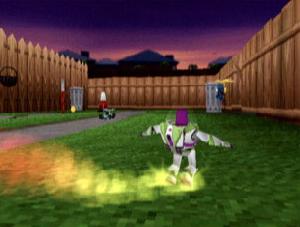All Buzzed up with nowhere to go.
Games made from movies…it makes a lot of sense. Lots of people watch movies.
Lots of people play video games. Hey! Let’s do some cross-marketing! Looks like
a good idea on paper, but it has been proven wrong many, many times over (with
a few rare exceptions like Goldeneye). Movies
based on games are sometimes even worse. Remember the Mario Brothers movie?
Street Fighter? I know I’m trying to forget them.
Take Toy Story, the first completely computer generated movie, a landmark
film and a toy advertising paradise. The sequel was a great film as well. There
was already a decent Playstation version
and an awful N64 version of the
game, and now we get the inevitable port to the Dreamcast. The result? You might
like it…if you still actively and unashamedly play with toys. Otherwise, you’re
probably too much of a grown up to enjoy this one.
The plot of the game follows the movie (bet you didn’t see that one coming).
A greedy toy collector, the kind of guy that never opens the packages that his
action figures came in, has kidnapped Woody, the pullstring cowboy doll. Oh
no! Those action figures might lose value. Boo-hoo. Anyway, Buzz Lightyear,
the Space Ranger, sets off to rescue his cowboy buddy.
Toy Story 2 is your basic, unoriginal 3D platformer. You control Buzz
on his mission to locate the whereabouts of Woody. Each level has five objectives
that can be completed in any order you like. For every objective you complete,
you receive a Pizza Planet token. In order to proceed and move on to new levels,
you must collect as many tokens as possible. Levels have Pizza Planet token
quotas that you must complete before you enter.
This setup is the all-too-familiar Rareware method of instilling replay value.
Sometimes it works, like in Tony
Hawk’s Pro Skater, and sometimes it doesn’t. In Toy Story 2, you’ll
just want to get rid of all your objectives at once, so you won’t have to repeat
the same stage over and over.
Most objectives require you to find all the hidden objects scattered about the
stage, things like Bo Peep’s Sheep or Mr. Potato Head’s missing mouth. Other times,
a different Toy Story character will challenge you to some kind of race.
An objective common to all levels is to find 50 coins and give them to the piggy
bank, Hamm. Never seen that before.
The levels feature fairly clever designs; there’s a clear, logical process to retrieving the missing objects. Nothing phenomenally new, but at least it isn’t just completely random. Perhaps the best part of the game is that all of the levels are seen from a “toy-sized” view, offering an interesting perspective on everyday environments.
Graphically, the game is sharper and more detailed than the Playstation version,
but still doesn’t hold a candle to Pixar’s polished movie. Everything has a bright,
slightly blocky look. In truth, the game has just been run through the ol’ port-a-matic,
rather than recreating everything in native Dreamcast from scratch.
 Buzz’s
Buzz’s
control is fairly tight in its simplicity. Everything is pretty typical of the
platform style game: run and jump and occasionally shoot. Buzz also has a “double
jump” move where he extends his wings in order to hover. You also have the run
of the mill spin attack and your “laser” to fight the evil Zurg toys (the arch
nemesis of the Space Rangers) that seem rampant everywhere.
The camera works fine, but not great. You can choose from either an active or
passive system. The active system has the camera automatically position itself
to face Buzz’ back. Expect moments of pause while you wait for the camera to catch
up. The passive system lets you manipulate the camera yourself. Oh, how I miss
the “camera-behind” button of Zelda
64 and other better games.
Even worse is that when you are battling boss characters, the camera decides to
always point directly at your opponent. Rather than being helpful, it becomes
an issue of fighting the camera rather than fighting the boss. It gets very annoying.
As a reward for making it through stages, you are given video snippets from the movie. With MPEG compression, the video is much higher quality than the other versions. Still, go out and buy the DVD if you’re just in it for the video.
Expect the usual bubble-gum kitsch fare for music. Some levels have short music
loops that get really irritating. There are also loads of voice samplings. As
much as I like the first Toy Story, the voices also get grating after a
while. Jessie, a new character in the sequel, sounds rather mannish in the game.
Like really mannish. A deep baritone, “Hey Buzz…” will alert you to her
testosterone saturated presence.
The game is obviously geared towards a younger crowd with its direct objectives
and translation of the movie. But there are a few harder challenges for better
gamers. Frankly, the only thing the game really has going for itself is the whole
Toy Story license. I would never have kept playing if it had been called
“Mr. Space-Dude and his Cowboy Friend.”
If you want to see video clips, go watch the actual movie. If you want a groundbreaking
3D platformer, you’re still looking in the wrong place, bub. Little kids might
be willing to look past the unoriginality and outdated gameplay; likely they
would even have some fun. But most kids, including those who are just kids at
heart, would be smart enough to play elsewhere.

-
Sharper graphics
-
Those cool Toy Story characters
-
Well designed levels...
-
...that only your kid brother will truly appreciate
-
Unoriginal and average
-
Subpar camera system







